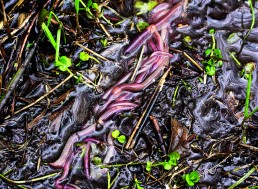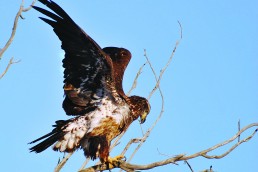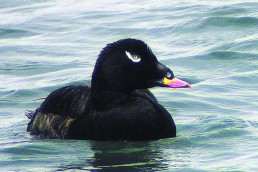Nature Notes
SHARE THIS POST
Skin it to win it
Particular rivers and streams in the Midwest contain a strange amphibian important for the ecosystem. Ever since hellbenders were discovered in the 1800s, they have been mystifying anyone ever lucky enough to encounter them. Unfortunately, hellbenders are declining at a very rapid rate. The biggest threat to hellbenders is loss of habitat and pollution. Its skin is full of flaps and creases, making it look like it has way too much skin. But the reason for this increased surface area is due to the fact that around 90 percent of the oxygen they breathe is absorbed through their skin. Because of this, they are extremely sensitive to pollutants and low oxygen levels in waters. In the U.S., they are the largest salamanders, growing up to 2 feet. Both the Ozark and Eastern hellbender are hurting now, and are in need of serious conservation. With groups starting to capture, rear and monitor their populations, perhaps they will soon increase.
Swan song rewritten
In 1933, the largest species of waterfowl was almost gone as the majestic trumpeter swan was in grave danger. Nearly double the size of tundra swans, trumpeters were once thought to be lost. But in the 1950s, thousands of trumpeters were discovered along the Copper River in Western Alaska and Canada. The population of fewer than 100 in Yellowstone was thought to be the last. Trumpeters were wanted for their meat, skin, and feathers and were also considered a game bird. Sixty years after the discovery of the second population, their population has grown 400 percent and is still on the rise. According to the last survey, over 24,000 trumpeter swans reside in North America.
Heard but not seen
Sometimes a backyard can hold some of the most fascinating creatures. The cicada, with their loud calls, is an example and can be heard constantly though not seen. Their appearance is frightening, and they look like a common housefly on steroids with oversized wings. Their long larval stage all starts with a small, tube-shaped egg that has been laid on a tree. The female slices open a small foundation to lay the eggs called “flagging,” which provides food for the newly hatched young. When the young have gotten a sufficient amount of food, their journey into the ground begins. Depending on the species, they may not see daylight again for 2 to 17 years. When they emerge, nymph cicadas climb the nearest tree, shed their old exoskeleton and wait for their new wings and exoskeleton to dry. Cicadas have a short adult life, and all of their time revolves around mating. The males call and the females respond. After mating, cicadas will start to die off.
Are you enjoying this post?
You can be among the first to get the latest info on where to go, what to use and how to use it!
Worms down to earth?
Invasive species are being identified, but some manage to slip through and become another part of the ecosystem. One invasive we have accepted as part of the ecosystem is the earthworm. After the last ice age, parts of the soil lost all of their native earthworms, including the upper Midwest. Fungi and other bacteria working with small plants have done the job in its place of nutrient and organic dynamics. About 30 percent of worm species found in North America are invasive. Scientists say in some forests where there have been no need for worms—and after they’ve been dropped there as a dumping ground for unused bait—evidence suggests that worms will remove low-lying plant species including the root systems of small trees, flowers and shrubs.
Wild Rice-A-Roni, the midwestern treat
For select groups, fall is the traditional time for harvesting wild rice. This rice is more than just a food source for Native Americans. For the Ojibwe, the wild rice is legendary and used for ceremonies. Collecting wild rice takes time. The first step is using some sort of watercraft like a canoe to reach rice beds. Once there, a long paddle called a “knocker” gently bends the rice stalks over the canoe while another knocker gently makes the rice fall into the boat. After sufficient amounts are collected, wild rice needs to dry quickly. Sun, airflow and heat are needed to ensure proper drying. Parching is done, which involves placing the rice in or on a vessel over a fire, stirring and heating until the hull is loosened and the rice turns brown. To remove the hulls from the dried rice, it is put in a hole and walked on to removes the hard hull. Finally, “winnowing” is done by placing the rice onto a flat object and shaken, which helps the hulls blow away. The rice then is ready to be cooked. This complex process has been done for a very long time, and is a piece of history for the original people of the Midwest.
The ‘lengths’ eels have to go to
Many animals go to crazy lengths to breed, but one comes close to taking the cake—The American eel. They breed in the Sargasso Sea in the middle of the Atlantic—a seeming impossible challenge for 3- or 4-foot eel. Once they reach these waters, scientists don’t know what happens to them next or where they exactly go. It is known that adult American eels will only mate once, and that every member of the opposite sex is a potential mate. When breeding has taken place, eggs are laid and hatch close to one week thereafter. Young eels start in a stage “leptocephalus,” where they are small, transparent eels, and do not resemble adults. Next, the eels start getting closer to shore and start to gain pigmentation where they are called “elvers,” and are not male or female. After a couple of months, they are sexually immature versions of adults, depending on whether they choose to stay in brackish water or migrate up a river, which depends on growth rate. Years later, when ready to breed, eels turn into what is called a “silver eel,”—the continuation of metamorphoses apparently happen in order for them to return to the Sargasso Sea.
MWO
SHARE THIS POST
Did you enjoy this post?
You can be among the first to get the latest info on where to go, what to use and how to use it!
Calvin Vick
MidWest Outdoors’ “Nature Notes” columnist Calvin Vick is an undergraduate studying biology, with an emphasis on herpetology, at the University of Central Arkansas. His primary interests are venomous snakes and salamanders. He spends most of his free time photographing the two.



